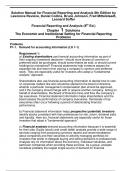Exam (elaborations)
Solution Manual for Financial Reporting and Analysis 8th Edition by Lawrence Revsine, Daniel Collins, Bruce Johnson, Fred Mittelstaedt, Leonard Soffer
Solution Manual for Financial Reporting and Analysis 8th Edition by Lawrence Revsine, Daniel Collins, Bruce Johnson, Fred Mittelstaedt, Leonard Soffer
[Show more]



